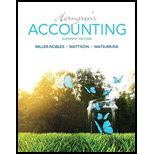
Concept Introduction:
TQM:
TQM stands for total quality management. TQM focuses on the overall quality of the product. It focuses on providing high product to the customers with the least defect possible. So that the confidence of the customers over the company and the product can be gained, that will overall benefit the business.
E-Commerce:
E-Commerce can be defined as the business done through internet i.e. goods are purchased and sold, services are provided through internet all over the world.
Triple Bottom Line:
Triple Bottom Line can be defined as the concept which focuses on including social and environmental factors to be considered along with the economic factors of the business, thus, it is termed as triple bottom line.
ERP (Enterprise Resource Planning):
ERPs are the software programmes designed as per the needs and the requirements of the business. It can be defined as a programme that combines all the operational activities and coordinate all of them together.
JIT (Just In Time):
JIT can be defined as the concept which focuses on the keeping only required amount of inventory as per the current demand.
To match:
Definitions:
1. A philosophy designed to integrate all organizational areas in order to provide customers with superior products and services while meeting organizational objectives. Require improving quality and eliminating defects and waste.
2. Use of the internet for business functions such as sales and customers service. Enables companies to reach customers around the world.
3. Evaluating a company’s performance by its economic, social and environmental impact.
4. Software System that integrates all of a company’s functions, departments, and data into a single system.
5. A System in which a company produces products just when they are needed to satisfy needs. Suppliers deliver materials when they are needed to begin production, and finished units are completed at the right time for delivery to customers.
With terms:
a. ERP
b. JIT
c. E-commerce
d. TQM
e. Triple Bottom Line.
Want to see the full answer?
Check out a sample textbook solution
Chapter 18 Solutions
Horngren's Accounting (11th Edition)
- Elmont Industries issues $2,400,000 of 8% bonds at 101. What is the amount of cash Elmont would receive from the sale? A. $2,373,000 B. $2,240,000 C.$2,424,000 D. $2,185,000 E. None of the above. Help mearrow_forwardPlease explain how to solve this financial accounting question with valid financial principles.arrow_forwardCan you help me solve this general accounting problem with the correct methodology?arrow_forward
- I am looking for a step-by-step explanation of this financial accounting problem with correct standards.arrow_forwardTyson manufacturing company produces and sells 120,000 units of a single product. Variable costs total $340,000 and fixed costs total $480,000. If each unit is sold for $12, what markup percentage is the company using?arrow_forwardI am searching for the correct answer to this general accounting problem with proper accounting rules.arrow_forward
- Need helparrow_forwardI am looking for the correct answer to this general accounting problem using valid accounting standards.arrow_forwardA company paid $36,000 for a 3-year insurance policy on January 1, 2024. The payment was recorded as a prepaid expense. What is the adjusting entry required on December 31, 2024?arrow_forward
- The financial statements of the Patterson Industries reported net sales of $875,000 and accounts receivable of $95,000 and $65,000 at the beginning of the year and end of the year, respectively. What is the receivables turnover ratio for Patterson?arrow_forwardI am looking for the correct answer to this general accounting question with appropriate explanations.arrow_forwardElmont Industries issues $2,400,000 of 8% bonds at 101. What is the amount of cash Elmont would receive from the sale? A. $2,373,000 B. $2,240,000 C. $2,424,000 D. $2,185,000 E. None of the abovearrow_forward

 AccountingAccountingISBN:9781337272094Author:WARREN, Carl S., Reeve, James M., Duchac, Jonathan E.Publisher:Cengage Learning,
AccountingAccountingISBN:9781337272094Author:WARREN, Carl S., Reeve, James M., Duchac, Jonathan E.Publisher:Cengage Learning, Accounting Information SystemsAccountingISBN:9781337619202Author:Hall, James A.Publisher:Cengage Learning,
Accounting Information SystemsAccountingISBN:9781337619202Author:Hall, James A.Publisher:Cengage Learning, Horngren's Cost Accounting: A Managerial Emphasis...AccountingISBN:9780134475585Author:Srikant M. Datar, Madhav V. RajanPublisher:PEARSON
Horngren's Cost Accounting: A Managerial Emphasis...AccountingISBN:9780134475585Author:Srikant M. Datar, Madhav V. RajanPublisher:PEARSON Intermediate AccountingAccountingISBN:9781259722660Author:J. David Spiceland, Mark W. Nelson, Wayne M ThomasPublisher:McGraw-Hill Education
Intermediate AccountingAccountingISBN:9781259722660Author:J. David Spiceland, Mark W. Nelson, Wayne M ThomasPublisher:McGraw-Hill Education Financial and Managerial AccountingAccountingISBN:9781259726705Author:John J Wild, Ken W. Shaw, Barbara Chiappetta Fundamental Accounting PrinciplesPublisher:McGraw-Hill Education
Financial and Managerial AccountingAccountingISBN:9781259726705Author:John J Wild, Ken W. Shaw, Barbara Chiappetta Fundamental Accounting PrinciplesPublisher:McGraw-Hill Education





